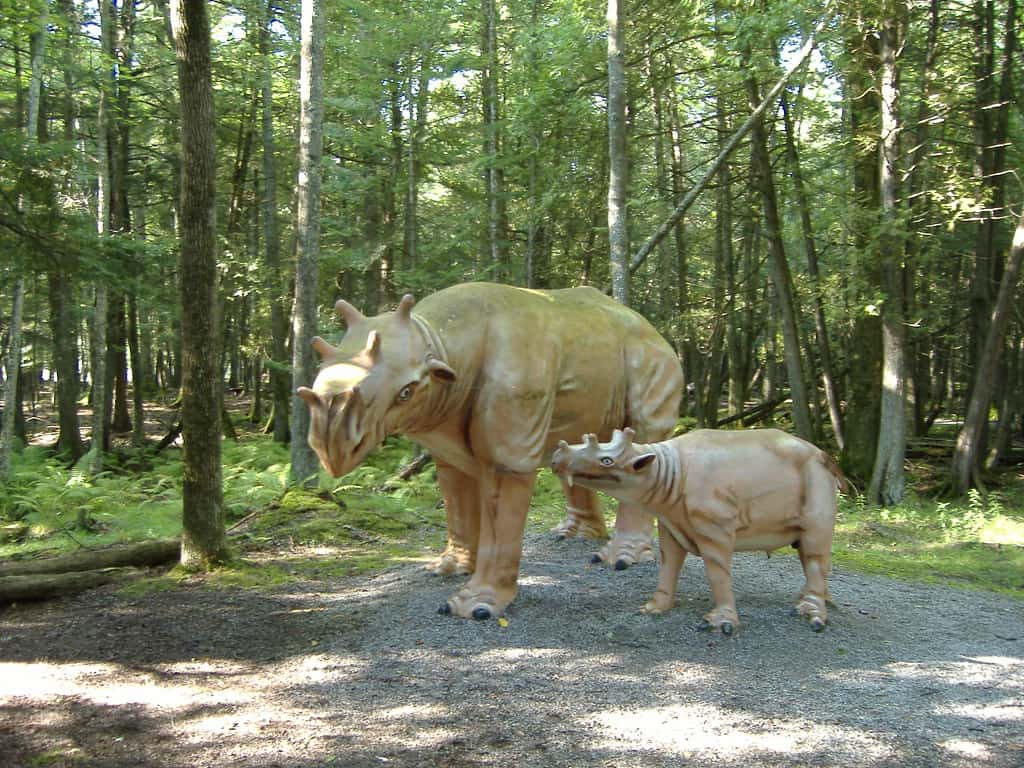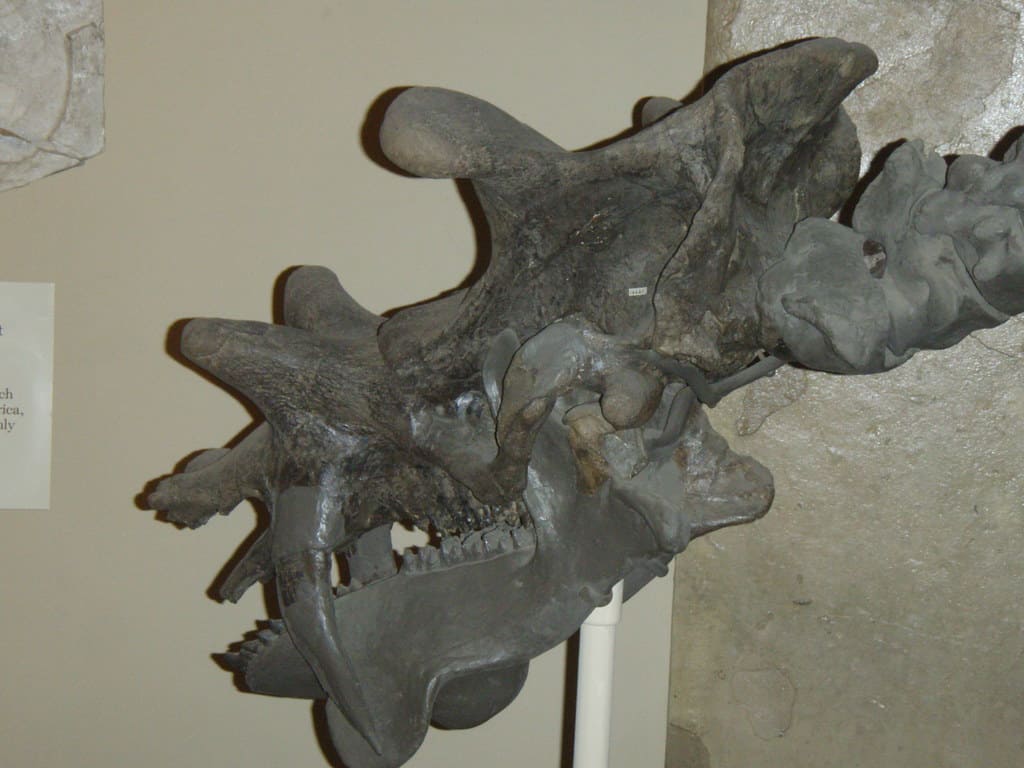It’s okay to wonder how an animal like the Rhinosaur existed. If you can imagine what it would look like for a Rhinoceros to have horns on top of its head, with teeth similar to a saber-toothed cat’s, you have an idea of how this creature looked.
The word Rhinosaur (popularly known as Uintatherium) was coined from the combination of Rhinoceros and Dinosaur because the rhinosaur is a dinosaur that resembled a rhino. Amazing right?
A close look at this creature will make you think it resulted from a cross between a dinosaur and a rhinoceros. The body size of the Rhinosaur was quite enormous. This post will walk you through everything you need to know about the Rhinosaur that possessed gigantic fangs and weighed about 2 tons.
Full Description and Size of Uintatherium
An average size Uintatherium was about 13 feet in length, almost as long as a Volkswagen Beetle, 5.6 feet in height, and weighed about 2 tons. The Uintatherium looks a lot like a rhino in size and shape. It also possessed robust legs to support its massive weight. In rhinos today, their breastbone is composed of compressed vertical segments. But the case was different for the Uintatherium. Their breastbone was made of horizontal segments.
The skull of Uintatherium was quite exceptional and different. The skull is quite thick and strong and has some places flat, while some places are curved. This type of skull is something you will hardly see in mammals. However, its brain was relatively small because the thickness of its skull only provided little space for its brain. The weight of the skull isn’t as weighty as it seems due to the presence of several sinuses.
One thing quickly recognized in a Uintatherium is its three pairs of knobby horns located on top of its head. The horns, made of keratin, are bony and covered with skin. However, these horns could only be found on the males. The females never had horns. This absence of horns is why it is believed that the males made use of the horns to attract their female counterparts for mating. It is also believed that these horns were used in contests.
They also possessed large canines or fangs in the upper region of their jaw. These fangs weigh about 2 tons. It is believed that these large canines were used in defense and, most importantly, for feeding on plants. The size of these canines was bigger in males than the females.

An adult uintatherium was the size of a small car and weighed 2 tons.
Origin of the Name “Uintatherium”
The name Uintatherium was given to this beast in 1872 by Joseph Leidy. The name means “Beast of the Uinta Mountains” because the Uinta mountains are close to where the fossils of this creature were first discovered. It also covers part of Utah and Wyoming.
Diet – What Did Uintatherium Eat?
The Uintatherium was an herbivore and specialized majorly in eating aquatic plants. It is believed that their gigantic fangs were helpful in their feeding. They most likely used the teeth to uproot plants that have been buried and drag out many aquatic plants from the water.
Uintatherium must have specialized in feeding on soft vegetation because the other teeth in the mouth were tiny and not suitable for chewing tough vegetation. So their soft teeth could only chew soft vegetation.
When and Where Did the Uintatherium Live?
It has been discovered that the Uintatherium existed in two different world regions during the Eocene epoch. Two Uintatherium species are well recognized.
They are the U. anceps and the U. insperatus. The U. anceps lived in the United States between the early and middle parts of the Eocene, about 56-38 million years ago. The U. insperatus lived in China from the middle to the late part of the Eocene, about 48-34 million years ago.
The Uintatherium was also most likely found around wetlands covered by soft vegetation. Since their small teeth didn’t support the consumption of tough plants, they must have been found in areas with soft aquatic plants.
Major Threats And Predators of Uintatherium
Due to the size of the Uintatherium, predators in the apex of the pyramid couldn’t prey on them. It becomes more challenging to take them on when they move in groups.
The only groups of Uintatherium that could have been victims of predation were the younger ones and the aged ones. Some carnivorous mammals that also lived in the late part of the Eocene must have taken on them. An example is the Andrewsarchus.
Discoveries and Fossils – Where It was Found
Uintatherium fossils were first discovered in the late 19th century by W.N. Wann in the Bridger Basin near Fort Bridger in Wyoming. The Uintatherium is one of the best-known and most popular American fossil mammals. The Uintatherium fossils were the primary agent behind the bone wars between paleontologists Othniel Charles Marsh and Edward Drinker Cope.
They were both striving hard to beat one another in naming and discovering animals. Even when they discover the remnants of the same animal, they will disagree on the name to give the animal. They often end up naming the same animal differently and coming up with individual theories.
However, the name Uintatherium had already been given to the animal by Joseph Leidy even before they started their disagreements. At the end of it all, the name Marsh and Cope gave to the animal only stands as a synonym for the real name.
The fossils of most animals that existed in the Eocene epoch are primarily found in the Bridger Basin, which is also where most Uintatherium bones were discovered. Today, you will find the skeleton of Uintatherium on display at the Utah Field House of Natural History and also at the Smithsonian National Museum of Natural History located in Washington, DC.

Uintatherium had horns on top of its head and resembled a modern rhino with fangs
When Did the Uintatherium Die Out?
The Uintatherium went into extinction about 38 million years ago. This extinction happened during the Bartonian age of the Eocene Epoch. Paleontologists believe that they went into extinction due to climate change and the presence of large brontotheres like Meacerops and primitive rhinos like Metamynodon.
They most likely out-competed Uintatherium for food access. They suddenly vanished off the earth during the late Eocene epoch, leaving little fossils behind.
One exciting thing about Uintatherium is how they could escape extinction for a very long time. They didn’t possess most attributes found in animals that survived extinction and lived very long.
Based on the size of their brain with their hefty body, they shouldn’t be intelligent enough to have survived for as long as they did. The Uintatherium didn’t even pass the intelligence test, yet they survived longer than many mammals known to be intelligent. This prolonged survival is why this animal remains a very mysterious beast.
Animals that Are Similar to the Uintatherium
Below are some other animals that were similar to Uintatherium. They include the following:
- Arsinoitherium: Arsinoitherium species were rhinoceros-like herbivores that existed during the late Eocene and early Oligocene of northern Africa. They existed about 30 – 36 million years ago. They were primarily found in tropical rainforests and mangrove swamps. Arsinoitheriums were about 5.9 feet in height and 9.8 feet in length. They also possessed a pair of knife-like horns projected from the nose and a second pair of knob-like horns on their head.
- Dinocerata: The Dinocerata is an extinct herbivorous animal whose remains were from the Paleocene and Eocene deposits of Asia and North America. They grew as large as elephants. They possessed three pairs of horn-like outgrowths, while species that were discovered later had the projection on their nose. Dinocerata had tiny brains, and their teeth were not adapted to grinding food. These could be reasons for their extinction. They mostly lived near water bodies and fed on soft vegetation.
- Paraceratherium: Paraceratherium is one of the largest terrestrial mammals to have lived. They mainly existed between the early and late Oligocene epoch, about 34 – 23 million years ago. They had heights of about 15.7 feet and lengths of about 24.3 feet. It weighed about 15 – 20 tons. It possessed a long neck with a skull about 4.3 feet long.
- Andrewsarchus: Andrewsarchus existed during the Eocene epoch in Mongolia, China. It has only one recognized species, which is the A. mongoliensis. This species was known from a skull discovered by the American Museum of Natural History in 1923.
The photo featured at the top of this post is © CC BY-SA 2.0. / Original
FAQs (Frequently Asked Questions)
At what time did the Uintatherium exist?
Rhinosaur, known as Uintatherium, was alive during the Eocene epoch. U. anceps lived about 56 – 38 million years ago, while U. insperatus lived about 48 – 34 million years ago.
What was the size of the Uintatherium?
The Uintatherium was about 5.6 feet in height and about 13 feet in length. It weighed about 2 tons. They also possessed robust legs capable of carrying their weight.
Does the Rhinosaur still exist today?
No, the rhinosaur went into extinction about 38 million years ago due to competition for food from other large mammals.
Thank you for reading! Have some feedback for us? Contact the AZ Animals editorial team.






